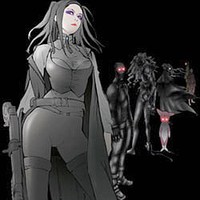Blame!
BLAME! (ブラム!, buramu!) is a ten-volume science fiction
manga by Tsutomu Nihei. A series of 6 short OVA episodes were produced based on the series.
The tagline for this manga is "Adventure-seeker Killy in the Cyber Dungeon quest!" or "Maybe on Earth, Maybe in the Future". There is some debate over the meaning of the title, which may be a mistranslation of the onomatopoeia "blam."
Basic plot
Killy, a silent loner possessing an incredibly powerful weapon known as a Gravitational Beam Emitter, wanders a vast technological world known as the Megastructure. He is searching for Net Terminal Genes, a (possibly) extinct genetic marker that allows humans access to the Netsphere. The Megastructure is an endless vertical space of walls, stairways and caverns, inhabited by scattered human and transhuman tribes as well as hostile cyborgs known as Silicon Creatures. The Net Terminal Genes appear to be the key to halting the unhindered, chaotic expansion of the Megastructure, as well as a way of stopping the murderous horde known as the Safeguard from destroying all humanity.
Along the way, Killy meets and joins forces with a resourceful engineer named Cibo and a tribe of human warriors called the Electro-Fishers. They are pursued by the Safeguard, who view any human without Net Terminal Genes as a threat to be extinguished on sight.
Style
BLAME! features extremely dark, highly detailed depictions of the fantastic, ever-changing world of the Megastructure, punctuated by brutal combat. There is generally little dialogue to support the action or story, and the reader is left to piece together the plot for themselves. Many scenes are spent on the long, lonely travels through the Megastructure.
The Megastructure
The Megastructure is actually a structure that began on Earth. The mechanical beings known as Builders, which move around reforming and creating new landscapes, appear to have begun building without end, creating an enormous structure with little internal logic or coherence. The Megastructure, and the Builders, were controlled by the Netsphere and the Authority but they have since lost the power to control the expansion of the Megastructure due to the chaotic and insecure manner of its growth. Without intervention by a user with Net Terminal Genes they cannot reestablish control over the Megastructure nor the Safeguards, whose original job was to eliminate any humans who try to access the Netsphere without Net Terminal Genes. The Safeguard now attempts to destroy ALL humans without the Net Terminal Gene as the degradation of the Megastructure has corrupted their true goals.
It has been suggested by Tsutomu Nihei himself in his artbook Blame! And So On that the Megastructure is actually a growing Dyson sphere of gargantuan proportions. Its spherical circumference is speculated to be roughly the size of Jupiter's planetary orbit (32.675 AU)[1]]. No evidence contradicts this speculation, and the prequel to BLAME!, NOiSE, even states that the structure has passed the orbit of the moon.[2]
Main characters
Main article: BLAME! characters and structures
Killy (霧亥, Killy?)
The main character. He is on a journey to find a human with Net Terminal Genes to access the Netsphere. He is equipped with the Gravitational Beam Emitter, a small but incredibly powerful weapon capable of destruction on a massive scale.
Killy's origin and motives are unknown. He speaks little and rarely hesitates to fight. He has shown superhuman levels of endurance and strength, and appears to be able to heal extremely rapidly. Usually, however, he relies on his GBE to dispatch the opposition. Killy appears to be linked in some fashion to the villainous Safeguard, but exactly how is uncertain. It has been suggested that Killy is an early if not prototype version of the safeguards seen in the manga.
Cibo (シボ, Cibo?) (also addressed as Cibo Shuninkagakusha (シボ主任科学者, Cibo Shuninkagakusha?), "Chief Scientist Cibo")
Head scientist of a corporation in the Capitol. She tries to access the Net Sphere with an artificially created version of Net Terminal Genes, but the experiment fails with disastrous results and summons the Safeguard, leading to the destruction of the entire facility.
During their journey, Cibo undergoes many changes of bodily form, emphasizing the transhuman nature of life in the Megasphere. Cibo cracks security systems and gathers information to help her and Killy's journey. She speaks rather more than the taciturn Killy, often serving to advance the plot.
Sanakan
A high level agent of the Safeguard who first appears as a short, young girl with black hair. She appears to have a particular interest in wiping out the human tribe of Electro-Fishers, and seems to know Killy from the past.
Source: http://en.wikipedia.org/wiki/BLAME%21
My inspiration:
The color which is extremely dark in this manga brings the felling of thriller, terror and sad. Also with little dialogue, this manga brings a strange felling about the world in the future when people must fight for survival.







